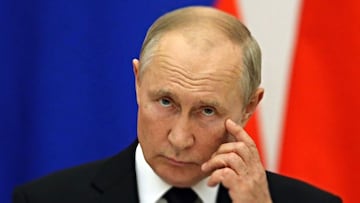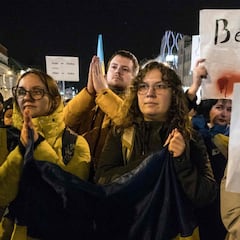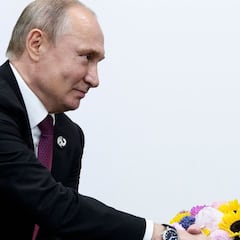What is the origin of the conflict between Russia and Ukraine? What is Putin's end goal?
Putin gave the order for Russian forces to begin military operations in Ukraine before dawn on Thursday. The West had been expecting it, but what is the conflict about?

For the past week, there had been daily reports, citing US intelligence sources, that Russian President Vladimir Putin had already decided on a date to commence an invasion of Ukraine. The offensive began before dawn on Thursday while the majority of the country, or at least those who haven't fled, were tucked up in their beds, fast asleep.
Related articles:
- Ukrainian and Russian armies compared
- Biden promises swift response in White House speech
- What Donald Trump thinks about Putin's invasion
- Russia recognizes two regions in Ukraine as independent leading to US sanctions
- Russian sanctions
Joint military exercise
The Kremlin had mobilised around 100,000 Russian troops in late November. Invasion forces were assembled in Belarus, Crimea and on the eastern border, close to the Donbas region, on the pretext of conducting military exercises and drills, some of which to be performed jointly with Belarus to the north. Those military exercises were due to end on 20 February but were subsequently extended, with Belarus Defence Minister Viktor Khrenin explaining that they were “designed to ensure an adequate response and de-escalation of military preparations of ill-wishers near our common borders”.
The Russia-Ukraine conflict is a complex affair and a result of a series of historical moments, broken promises, mistrust and suspicion on both sides - west and east. From 1922 until relatively recently, Ukraine was a satellite state of the federal Soviet Union, governed by the Communist Party of the Soviet Union (CPSU). That changed with the dissolution of the Soviet Union under Mikhail Gorbachev in the late 1980s. Between 16 November 1988 and 26 December 1991, the USSR ceased to become a sovereign state and a Commonwealth of Independent States (CIS) was formed. Russia became self-governing while Ukraine gained independence in August 1991 and Belarus a few months later. A couple of years earlier, the political landscape had also changed in central Europe with the reunification of Germany which signalled the end of the Cold War.
NATO expansion and the Russia-Ukraine conflict
The origins of the present conflict and Russian invasion of Ukraine can be traced by the expansion of NATO, the military alliance which was formed in 1949 under the North Atlantic Treaty, an initiative designed to “safeguard the freedom, common heritage and civilization of the peoples” following the widespread destruction during World War II.
However, after the dissolution of the Soviet Union and German reunification, NATO’s purpose had to be reviewed. At a meeting in Moscow on 9 February 1990, US Secretary of State James Baker assured Gorbachev that NATO’s forces “would not expand an inch eastwards” or act as a threat to Russia or the newly-independent, former Soviet states.
"Not an inch eastwards"
A transcript of that conversation is available in declassified documents, Baker told Gorbachev, “NATO is the mechanism for securing the US presence in Europe. If NATO is liquidated, there will be no such mechanism in Europe. We understand that not only for the Soviet Union but for other European countries as well it is important to have guarantees that if the United States keeps its presence in Germany within the framework of NATO, not an inch of NATO’s present military jurisdiction will spread in an eastern direction”.
However, just nine years after that meeting, Poland, the Czech Republic and Hungary - three former members of the Warsaw Pact, were accepted as members of NATO. As far as Moscow was concerned, NATO and the US had broken their promise.
Statement by the North Atlantic Council on Russia's attack on Ukraine#NATO | #Ukraine 🇺🇦 | #StopRussianAggression
— NATO (@NATO) February 24, 2022
Russia's relationship with NATO
NATO has an open-door policy, which means non-member states are free to join if they meet the alliance’s criteria and their submission is approved by the rest of the existing member states. Russia and NATO have cooperated on several issues such as the fight against terrorism but the Kremlin has always resisted the chance to join and relationships between the two deteriorated after the annexation of Crimea in 2014.
Zelensky speaks to the nation. He says he's declared martial law and urges Ukrainians to stay home.
— max seddon (@maxseddon) February 24, 2022
“We are working. The army is working," he says. "Don't panic. We are strong. We are ready for everything. We will defeat everyone. Because we are Ukraine.” pic.twitter.com/vamBb0pLWu
Ukraine invited to join NATO in 2008
Ukraine meanwhile, along with Georgia, Bosnia and Herzegovina are actively seeking to become signed-up members of NATO and that is what has irked Putin and the Kremlin, who feel that their own national security would be compromised. Ukraine was invited to join NATO at the Bucharest summit in April 2008. A statement read: “NATO welcomes Ukraine’s and Georgia’s Euro-Atlantic aspirations for membership in NATO. We agreed today that these countries will become members of NATO. Both nations have made valuable contributions to Alliance operations. We welcome the democratic reforms in Ukraine and Georgia and look forward to free and fair parliamentary elections in Georgia in May. MAP is the next step for Ukraine and Georgia on their direct way to membership. Today we make clear that we support these countries’ applications for MAP. Therefore we will now begin a period of intensive engagement with both at a high political level to address the questions still outstanding pertaining to their MAP applications. We have asked Foreign Ministers to make a first assessment of progress at their December 2008 meeting. Foreign Ministers have the authority to decide on the MAP applications of Ukraine and Georgia”.
24 февраля Владимир Путин заявил, что в ответ на обращение руководителей республик Донбасса принял решение о проведении специальной военной операции. Следите за нашей текстовой онлайн-трансляцией:https://t.co/tt1r5S0Mmp pic.twitter.com/ZIsbc0xP9D
— ТАСС (@tass_agency) February 24, 2022
Related stories
After decades of mistrust, President Putin evidently doesn’t want NATO on his doorstep. Before ordering Thursday’s invasion, this is what he had to say in a televised address to the nation. “Ukraine never had a tradition of genuine statehood. Modern Ukraine was entirely created by Russia, more precisely, Bolshevik, communist Russia. This process began immediately after the revolution of 1917. If Ukraine was to join NATO it would serve as a direct threat to the security of Russia. They try to convince us over and over again that NATO is a peace-loving and purely defensive alliance, saying that there are no threats to Russia. Again they propose that we take them at their word. But we know the real value of such words”.
Some commentators have suggested that Putin launched the military assault with the aim of reclaiming Ukraine as part of a broader plan to reconstruct the old Soviet Union. In the most recent broadcast, Putin justified the Russian invasion, describing it not as an invasion with the intention of occupying Ukraine but as “a special military occupation” and to “demilitarize and neutralise” the threat from their neighbouring country.

